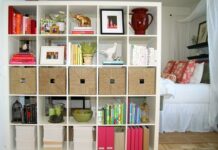By Melissa Rayworth
It’s yours, but it isn’t. A rented apartment or house can be a wonderful place to live, and a challenging place to decorate.
The restrictions are many: Landlords often want their white walls to stay white. Many won’t let you do even the most minor construction. Some even ask renters not to nail anything to the walls.
Complicating things further, many rental properties have small rooms and no-frills, builder-grade light fixtures, doors and cabinetry with little personality.
How can you inject some of your personality into a rented space without enraging your landlord?
The first step is to go all in.
“So often people think of their rental as not theirs, and therefore go through life not creating a beautiful home or nest,” said designer Kyle Schuneman, author of The First Apartment Book: Cool Design for Small Spaces (Potter Style, 2012). “Life is too short to not create a sanctuary that represents your unique vision.”
Home decorating blogger Wanda Hoffs gives the same advice to her readers at recreateanddecorate.com. As an Army wife, Hoffs has lived in many rental properties around the country and has learned to decorate each one as if it were truly hers.
Here are five ideas from Hoffs and Schuneman that can help you embrace your rented space.
“Usually rentals are small, and I am a firm believer in function before form,” Schuneman said. “Sometimes it’s a puzzle piece to get those ‘must haves’ into your space — the desk, the bed, the couch.”
He suggests using old items in new ways: Does the desk become a footboard? Should a small bookcase from your old living room be tucked into the corner of your new kitchen?
If your current furniture doesn’t fit well into a rental, Hoffs suggests spending wisely on new items. Rather than buying an expensive new piece that fits your rental perfectly, “use thrift store furniture and paint it yourself,” she said.
Used furniture can be “so inexpensive that you can sell it at a yard sale if need be” when you decide to move out of the rental. “It’s not about where you buy it,” Hoffs likes to tell her blog audience. “It’s how you use it.”
“Wallpaper used to be only for the homeowner crowd,” Schuneman said, “but now with companies like Tempaper, you can put up temporary wallpaper that peels on and peels back off when you’re ready to move.”
Hoffs suggests using wall decals, which now come in a huge range of styles and sizes, or even duct tape.
“It comes in many great colors and patterns,” she said, “and can be used on a wall in many different patterns, such as the trending chevron pattern, stripes or even to create a border around a wall grouping.”
If you want to do just a bit of painting that could be easily repainted before you move out, Hoffs and Schuneman both suggest painting a stenciled design on one wall. Or paint a band of bold color along the top of your walls.
To make the eventual repainting easier, Hoffs said, “always know the original color and brand of paint.”
“If you’re afraid to touch your walls or have a really difficult landlord,” Schuneman said, “bring in the color through fabrics and textures around the room. If you leave your walls white, hang a bold curtain on the windows and a coordinating couch that really pops.”
Hoffs agrees: “Fabric can be a great, inexpensive way to add color, pattern and texture to a room. It can be framed or stapled to a large art canvas to be hung on the walls,” to add a burst of color. You can also attach fabric temporarily to a wall using spray starch.
Lush plants are another option: “Bring in plants to add life, color and to warm up your home,” Hoffs said. Even if you’re not a gardening expert, “there are many low-maintenance ones for those who do not have a green thumb.” When it’s time to move, they’re easy to take with you.
“Your floors are a blank slate for design,” Schuneman said. “Treat it as your fifth wall and find a beautiful rug to ground the whole space.”
Schuneman is a fan of FLOR carpet tiles, which can be arranged to make what appears to be a rug of any size. “I love using FLOR tiles for rentals because they can be put together in different configurations when you move and can be personalized, so only you have that certain pattern that represents your style,” he said.
Although you can’t change the cabinets in your rented kitchen or bath, Hoffs points out that you can swap out the hardware on doors and drawers at a very small cost.
“You can always change these back to the original ones when you start to move,” she said, as long as you remember where you’ve stored the originals.
The same goes for light fixtures. A change of lighting can add “instant drama” to your home, Hoffs said, so consider swapping out the current fixtures with ones that reflect your taste. Just be sure to store the landlord’s fixtures carefully and reinstall them properly before moving out. — AP












